| |
RA 3910 is a 1927 Daimler 20/70 Model Q with doctor's coupe bodywork by Sanderson and Holmes of London Road, Derby, and is now back on the road for the first time since 1940.
When we acquired it, the vehicle had covered less than 25000 miles from new, which is rather low when compared with the thousand miles a month expected in the owner's instruction manual.
The car is fitted with a straight-6, 2.6 litre sleeve-valve engine. This type of engine is very quiet, as there are no tappets hammering away, nor are there poppet valves hammering into their seats. Instead there are steel sleeves sliding smoothly between the cylinder wall and the piston, all operated from a secondary crankshaft. The only thing going "bang" is the mixture in the cylinders. The downside is that it is difficult to seal all that machinery in the cylinder bore, which means that many sleeve-valve cars leave a trail of oil smoke.
|
| |
So how does a sleeve valve engine work?
The type of engine used in our Daimler was invented in the early 20th century by an american called Charles Yale Knight. Because of their inherent quietness, they are referred to as "Silent Knights".
Between the piston and the cylinder wall there is an inner sleeve and an outer sleeve. As these are pushed and pulled by con rods, at the relevant times slots in them line up with the ports in the cylinder wall. That's three lumps of metal moving up and down in each cylinder. Unfortunately some power is used to move the sleeves, a situation which was improved in 1925 when Daimler switched from cast iron to light steel sleeves. The top end of the arrangement is sealed by the cylinder head, which has rings to seal against the inside of the inner sleeve. This is known as the junk (short for junction) ring.
If you want to see how it all fits together, there is a video of a cut-away cylinder of a Knight sleeve-valve on YouTube. Have a look here .
|
| |
The first owner of RA 3910 was Harry Rawson of Borrowash, to the east of Derby. He worked for the London Midland and Scottish Railway Company, and had a well paid position in the Carriage & Wagon Works stores. In 1911 he was earning £200 a year and employing a servant.
The chassis of our car cost him £550, and the bodywork and extras probably added £400 to the figure. At official inflation figures, that's about £48,000 of today's money. The 20/70 Model Q was next to the bottom in Daimler's range. One had to be well-off to drive a Daimler! Harry Rawson, though, was earning £700 a year as Carriage & Wagon Works Stores Controller in 1927, and had a telephone at home - Spondon 4.
Interestingly, Rawson was not his real surname. His birth and baptism were under the name Stafford, but Rawson was a name his father Thomas sometimes used. Stafford was not Thomas's real name either - he married twice, both times under his real surname of Jones !
The bodywork is by Sanderson & Holmes, of London Road, Derby. This company started out as Holmes & Co., coachbuilders, in the 19th century. They were obviously a go-ahead company, being early adopters of the telephone. They appear in the 1896 phone book, with the same number which appears on the coachbuilder's plaques on RA3910 - Telephone 8, Derby.
Over the years, Sanderson & Holmes became luxury car dealers, the showroom supplying Rolls-Royce and Bentley as well as Daimler. They eventually closed their doors in the late 1960s, and their account books ended up in the Derbyshire Record Office. The ledgers show the purchase of our chassis from Daimler, price £479, and its sale to Harry Rawson at Daimler's official price of £550, plus bodywork. Unfortunately the coachbuilding department only has monthly totals in the ledgers I've seen, so I can only estimate the total.
|
| |
The car did not stay in Derbyshire very long, however. At the end of 1929, it passed, via David Rosenfield, a car dealer in Manchester, into the ownership of Dudley Pearson Bullough of Whittle-le-Woods, Lancashire. He lived at a grand house called Two Corners, which later became a nursing home. The Bullough family were from Atherton, and made their money through a grocer's shop and a business making nuts and bolts. In 1921, Dudley was working at Woodward's garage in Atherton as a motor salesman, so probably recognised a good car when he saw one.
During the 1930s, Mr. Bullough had the car repainted green. Traces of the colour were found in various places during restoration.
As war came, the car was laid up. The log book shows that it was last taxed in 1940, but it is unclear whether it was being run, or just taxed in order to get the allocation of petrol coupons. Either way the car did not see the light of day for many years afterwards.
|
| |
The car was discovered by a friend of my father's, Percy Collinson, and purchased. My dad towed the car home for him, and Percy started work on the car. He stripped many of the components, then started on a colour change. Many coats of hand-brushed coachpaint were applied, with much rubbing down. Unfortunately, the "cream" turned out much too yellow, and the "burgundy" turned out much too red.
Some time into the restoration, his progress being greatly slowed by illness, some vandals set fire to the garage where the car was being worked on. Luckily the fire station was very close, and quick-thinking firemen rolled the Daimler outside.
My dad offered half of his garage to keep RA3910 in, and the vehicle was towed the half mile to its new location. Percy was reluctant to let us work on the car as he wanted to do the work himself, but illness prevented him from doing so.
His illness eventually got the upper hand, and when he died we bought the Daimler from his estate. By then it had been in my dad's garage for over seven years.
|
| |
It took us some time to work up courage to start on our very first car restoration - about four years in fact. Then we took stock and worked out what we could do ourselves and which jobs would need professional help.
This was the car as we decided what to do:
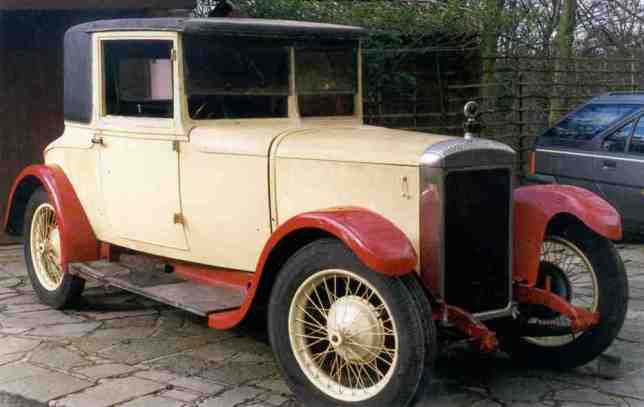
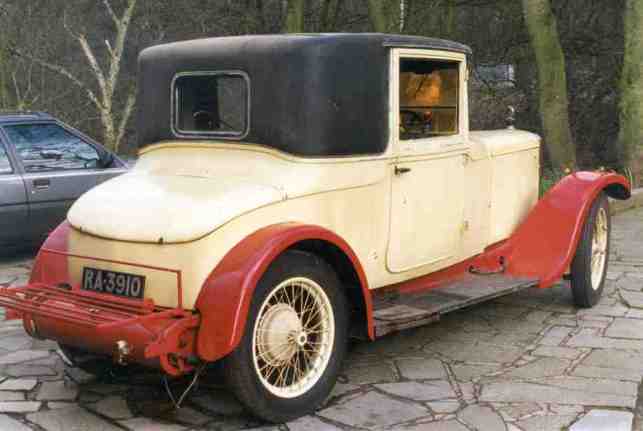
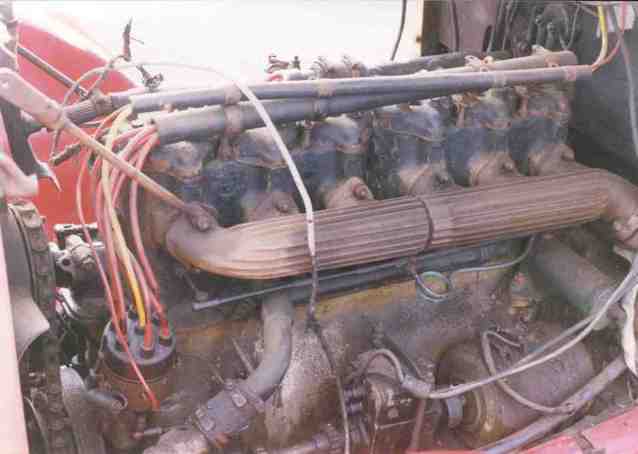
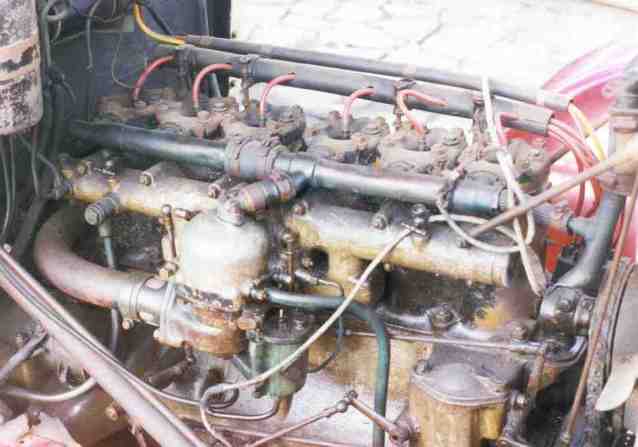
You can see that the car was pretty well complete, though definitely needed a good clean. Several attacks of commercial degreaser made some impact, with much scrubbing of the engine bay resulting in a much improved appearance.
While cleaning the underside we found that one end of the silencer did not line up with its mounting hole and had a wire rather than a bolt holding it in place. A suitable bolt was quickly located and the wire removed. A trolley jack was placed under the silencer, but lifting did not result in the expected re-alignment. The car roof, though, did nearly touch the ceiling. The wire was reinstated.
|
| |
We looked around for someone who could do those jobs on the Daimler which we had no chance of completing alone. We noticed a name which was unexpected - Horsfields of Halifax. This was a place which we had driven past hundreds of times, but did not connect with vehicle restoration. We had, though, noticed their fleet of vintage Rolls-Royces, in constant use for weddings. Knowing that Horsfields were used to dealing with cars of quality, we made further enquiries. Up the side of the valley from the showroom is their restoration workshop, a converted brewery building.
Horsfields arranged for us to work on RA3910 ourselves, with them undertaking the jobs which we could not do ourselves. Over several months we "visited" at weekends. Progress was made, with various engineering jobs being done by experts. We would leave at the end of a day's work, and on our return, some job or other would have been completed. They already had trustworthy suppliers for jobs such as relining brakes. We decided not to take up the quote they obtained for the paintwork; their usual paint artist produces a wonderful finish, but we decided that it would not look right on our car, as such a brilliant gloss would have been impossible in 1927.
We eventually reached the point where the engine was running, and we could bring our Daimler home.
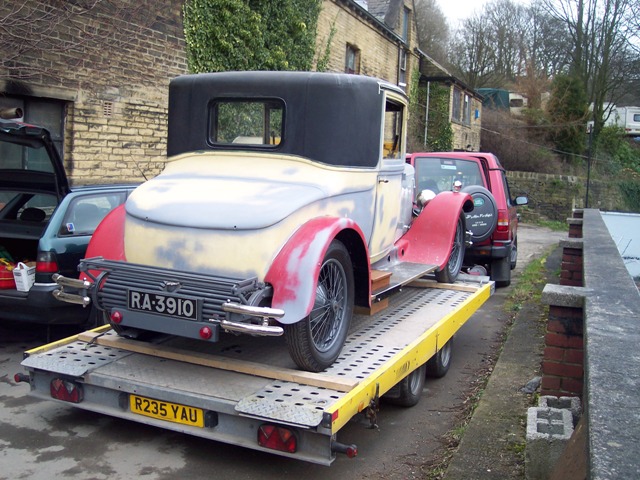
|
|
|
|





































